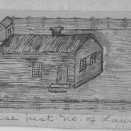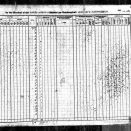
In 1836, Sherman Peck decided there was a need for law enforcement and declared himself the first town marshal. From 1837 to 1922, under the village form of government, the town’s protection was a lone marshal elected by the town council. Since Peck did such a great job the previous year he was officially elected as marshal in 1837.
Marshal Peck, and the other law officers up until 1882, had their own offices anywhere they chose, often in their homes or a convenient barbershop. The marshal could also assign volunteers to be his assistants. In the year 1882 a City Hall was erected and the constable’s office and the fire department had a new permanent home in the basement.
The marshals of our village were not the type you see in frontier towns on television. They were far from being gunslingers only one step within the boundaries of the law – they were responsible citizens who set good examples for the townspeople instead of ruling by fear. They were reliable men who displayed their steadfastness many times before being entrusted with keeping the peace.
They generally relied upon their courage and wits when an unruly situation developed. For the most part their weapons only consisted of a billy club. Early Cuyahoga Falls lawmen had only to know right from wrong and be a big enough man to stand up to most any situation.

Gunfights on the city streets were unheard of in the pioneer days of Cuyahoga Falls. Only once did a marshal die after a scuffle and it had nothing to do with the “bad guys”.

Marshal Ira Goldwood, 48, had served as marshal in 1900 and 1901 and had been reelected about two months before his death.
A local shopkeeper’s horse escaped from his control and it took off running. Marshal Ira Goldwood attempted to stop the fleeing animal, and partially succeeded. The horse reared up and came down on him, crushing in his chest. The Marshal ended up with three broken ribs, a ruptured windpipe and a spinal injury. He never fully recovered and died from his injuries four years later.
The last town marshal was William Sanderson who held the job from 1916 until 1922.
Chief Russell H. Duffy completed an examination and took over for Sanderson as a full-fledged chief of police on January 12, 1922 when Cuyahoga Falls switched to a city form of local government. It was at this time Chief Duffy was given a corps of paid officers. Duffy held the post until 1946 when Menzo Preston became head of the police force.
Police headquarters were moved to the new city hall at 2310 Second Street on October 26, 1952, where they are today.
Copyright – Chapter taken from Cuyahoga Falls: River of Memories by Jeri Holland





